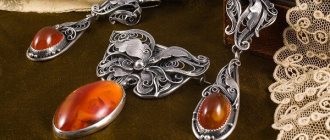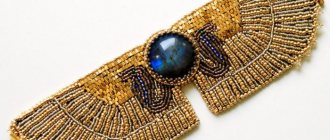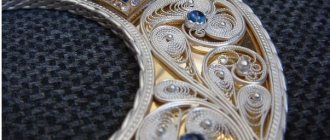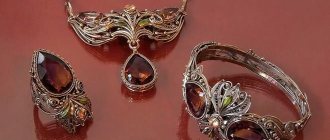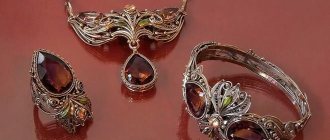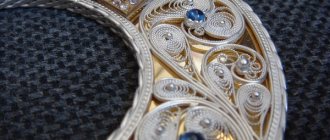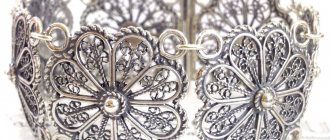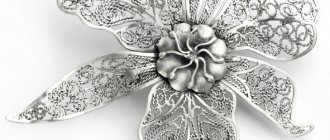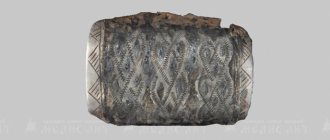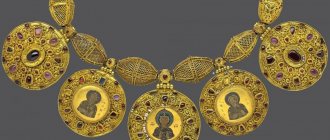Quote from Marina_Ushakova's message
Read in full In your quotation book or community!
Jewelry techniques: filigree, filigree, granulation and blackening
The names of these techniques are familiar to many, but not everyone can tell with confidence what the features of each of them are and how they appeared.
When creating jewelry, craftsmen use a large number of different techniques and techniques: thanks to them, each item acquires its own unique mood, value and significance. And, first of all, the quality of the jewelry depends on the skill and experience of the jeweler, because techniques such as filigree or granulation require enormous concentration, precision of movements and perseverance in their work.
SO:
Russian grain
There is evidence that grain in Russia is perhaps even older than filigree.
For example, medieval artifacts found in the Urals, dating back to the 8th century, contain grain. And filigree in this area appears only on objects from the 10th century. Decoration from grain can be found on temple decorations, pendants, rings, rings, earrings, as well as scabbards and other rich household items found in treasures. The patterns were very expressive, with a special play of light and shadow. Complex compositions were created. One of the interesting options is to fasten grains in the form of pyramids, which were used to decorate the product.
Particular attention to the graining technique that existed in the 10th-14th centuries is associated not only with archaeological excavations and the study of ancient artifacts. Of course, there is interesting evidence about the skills of our ancestors, who knew what grain was in various regions of the country. But modern jewelers, in order to create new works of art, are interested in repeating unique, ancient technologies that made it possible to create real masterpieces.
Grain
In Russian jewelry art, filigree and granulation techniques are inextricably linked. Grain is usually used to complement filigree patterns, giving them a fuller and more finished look. The simple name of the technique fully reflects its essence.
Grain is an ornament created from small, 0.3-0.4 mm in diameter, gold, silver or platinum grains. The balls are installed in pre-prepared recesses in the pattern on a thin layer of solder, which fuses them with the base in the flame of the burner. It is important that the solder can securely secure the pattern, but does not disrupt its clarity by spreading beyond the recess. In Rus', gold leaf mixed with mercury was used for these purposes; during the soldering process, the mercury burned out, and the gold quickly melted, forming a reliable adhesion.
Another condition for creating a high-quality pattern is the same size of all grains. To obtain them, thin wire is cut into small pieces, which are placed on pieces of charcoal, where recesses of a given diameter are located in rows; the molten wire flows into them, forming small balls, which will later be used for decoration.
The secret of skillful soldering of filigree and grain products
One of the most important issues for a master scanner is the cleanliness of the solder, which should not fill small parts and thereby disrupt the clarity of the pattern. On very ancient objects made of filigree and grain, the solder is so invisible that it seems as if some invisible glue is holding the individual parts together.
Old Russian masters of filigree work also achieved great purity of work. This question has long been of interest to scientists and craftsmen from different countries. The famous Italian sculptor and jeweler of the 16th century, Benvenuto Cellini, dwells on it in detail in his treatise on jewelry; Many attempts to repeat the ancient originals with their inherent purity of work were made in different years by Western European scientists, but all were unsuccessful.
The lost secret of the ancient technique of invisible solder was revealed as a result of experiments conducted by Soviet researcher Professor F. Ya. Mishukov. He proved that instead of solder, ancient jewelers used an amalgam of gold, silver and mercury.
Sheets of thinly flattened so-called gold and silver leaf were ground in the proper proportion with a small addition of mercury to obtain an amalgam of the desired thickness. This amalgam was used to smear individual parts of the filigree ornament and balls of grain, after which the object was strongly heated. The mercury evaporated, and the parts of the ornament were firmly connected to each other.
Diego Velazquez
Magnificent, mysterious, incomprehensible, more vital than life itself - this is how researchers characterize the work of Diego Velazquez.
Velasquez was incredibly lucky. A court painter who spent his life in communication with monarchs, who had the opportunity to travel and admire the most beautiful treasures of world art, he was treated to fame during his lifetime, receiving well-deserved recognition not only from the royal family, but also from other painters of his time. And this despite the fact that he managed to achieve the greatest truthfulness in his works, without flattering anyone, even the most powerful persons of this world. Velazquez receives such exceptional recognition well deservedly. Gifted with extraordinary talent, the artist hones his skills throughout his life and, thanks to extreme hard work, eventually reaches the highest creative peaks.
Early creativity. Seville period: 1617 - 1623
The individuality and originality of Velazquez is already evident in the early work of the painter, which includes the Seville period - 1617 - 1623. The canvases of this period were created in the bodegon genre (translated from Spanish as a tavern or tavern). These paintings usually feature several half-figures in domestic kitchen scenes or at meager breakfasts. These are mainly representatives of the common people, in whose depiction one can already see the realism of the image so characteristic of Velázquez. The most famous paintings of this period include the paintings “Breakfast”, “The Old Cook”, “Breakfast of Two Young Men”, “The Water Carrier”. As well as his early religious paintings: “Christ in the House of Martha and Mary”, “Adoration of the Magi”. They are characterized by a dark palette of colors, a dense and heavy manner of depiction, and sharp black and white contrasts. They do not yet have that synthesis of color and volumetric forms, reflections and shadows, skillful depiction of the light-air environment that distinguishes the master’s later works. These paintings are more remarkable for their masterfully thought-out composition, intriguing selection of colors and shades, and subjects in which the life of ordinary Spaniards is depicted with sincere respect and warmth.
Madrid creative period: 1623 – 1649
The years of his stay in Madrid contributed to the significant improvement of Velázquez's skill and the development of coloristic techniques. During these years, Velazquez gets the opportunity to study the treasury of the king's painting collection, has the opportunity to communicate with the Spanish cultural elite, and travels to Italy for the first time, which helps expand his artistic horizons. During this period, “antique” canvases, extremely unusual for Spanish painting, were created: “Bacchus or the Drunkards”, “The Forge of Vulcan”, with their characteristic irony and life-like authenticity. In them, the master extremely unusually combines a mythological plot with common everyday scenes, thereby synthesizing mythology and the real life of his time. So Velazquez's Apollo looks like an ordinary street rake, despite his divine attributes. The color palette in these paintings is extremely interesting, synthesizing the finest color shades that give the fragments of the painting extraordinary beauty. These tonal shades tie together individual fragments and add an unusual zest to the composition of the canvas, as do the luxurious colors of the silk lilac-pink cloak of Bacchus, embedded in the monotonous brown-gray background. ("Triumph of Bacchus").
A special place in the artist’s work is occupied by his only monumental painting in the genre of historical painting – “The Surrender of Breda”. This picture can be called a timeless canvas, because the philosophical plot depicted on it - the dialogue between the winner and the vanquished, could be inherent in any time and people. The nature of the work also breathes its own special philosophy. With its majestic calm, it reflects the eternal inviolability and equanimity of the universe, which is not worried or affected by human passions.
First trip to Italy: 1629 – 1631
During this period, Diego Velazquez continued to get acquainted with the treasures of world painting: the work of Van Dyck, Leonardo da Vinci, Venetian colorists - Titian, Tin Toretto, Paolo Veronese, Michelangelo, and made copies of their paintings. These observations introduce new touches of skill into his work - naturalness and charm in the depiction of characters, especially children, a masterful rendering of space and light-air environment. Velazquez's stay at the Villa Medici gives life to the wonderful landscape "Garden of the Villa Medici", where this magnificent architectural structure and the surrounding nature are depicted in the golden colors of the approaching sunset.
Portraits 30 – 40 years
Since Diego Velazquez was a court painter, during his life he painted a huge number of portrait works. But even in the most ceremonial images, he managed to breathe life and genuine truthfulness into the image. And this despite the fact that gesture, movement and individual accessories are absent in his portraits. And yet, his paintings are filled with life due to the airy background, the finest synthesis of colors and the effects of color combinations. The content side of the master’s portraits is also extremely interesting. Whoever Velazquez portrays, starting from the king and the most powerful persons of Spain, he portrays his heroes as they are, with the subtlest psychologism, conveying through appearance the inner individuality of the image, the character of his characters.
When, on his second trip to Italy, he portrayed the head of the church, Pope Innocent X, he so masterfully portrayed the inner toughness and cunning of his hero, while realistically describing the luxurious surroundings that surrounded him, that the pope had every reason for his famous comment: “Too true.” " But Velázquez’s portraits will be remembered by posterity not only for the depiction of the royal family and court nobility, but also for the portraits of the “orphan and offended” - royal dwarfs and jesters. In them, the master with the greatest sympathy conveys the tragedy of people offended by life and fate. People, sometimes smart and talented, aware of the whole drama of the contradiction of their inner spiritual content and external ugliness, or truly blessed ones who cannot understand the tragedy of their fate.
Second trip to Italy: 1649 – 1651
By the time of his second trip to Italy, Velazquez’s artistic taste, so contrary to Italian academicism, had finally taken shape. The portrait of his assistant Juan Pareja brought Velazquez such a triumph that Roman artists elected him a member of two academies. During this period, in addition to the famous portrait of Innocent X, he also painted portraits of some people from the papal circle.
Late period: 1650s
At this time, Velazquez reaches the heights of his mastery.
This period includes portraits of women and children of members of the royal court: Queen Marianna of Austria, Infanta Maria Teresa, Infanta Margarita, Infanta Philip Prospero, and a portrait of the aging Philip IV. And, of course, the most famous paintings by Diego Velazquez “Las Meninas” and “The Spinner”. The painting “Spinners” seems to continue the theme of Velazquez’s early mythological paintings, where there is a striking synthesis of mythological mysticism and contemporary realities of the artist. The master gives his own interpretation of the ancient myth, poeticizing the beauty and greatness of human labor and talent. His painting “Las Meninas” influenced the subsequent creation of paintings of the everyday genre. The plot of “Las Menin” is not just a group portrait of members of the royal court. The painting is distinguished by its most complex composition, in which Velazquez, thanks to his greatest technical skill, creates a complete sense of the real life of the characters and all the fragments of the canvas, asserting with his talent the true apotheosis of pictorial art. In this picture and in many of his creations, Velazquez was far ahead of his time and surpassed the achievements of many of his predecessors and contemporaries. He surpassed them both in his greatest technical skill, in his boldness in depicting the characters, and in his artistic design. After all, it was his brush that painted the portrait of a naked woman in the painting “Venus with a Mirror” - an audacity unheard of during the times of the harsh Inquisition, the rarest image of a nude in the history of Spanish painting. The widest coverage in the works of the master of various layers of social life in Spain in the 17th century is striking, showing the contrasts of nobility and poverty, folk life and the life of aristocrats. The artist's skill reaches such a level that the most complex technical techniques merge into one whole, becoming invisible to the viewer and leaving only an indescribable feeling of fascination with the picture. It is probably impossible to fully convey in words the magical charm of Velazquez’s paintings, but one thing is certain – the mysteries of the incomprehensible mastery of the great Spanish painter’s work will always excite true connoisseurs of authentic art.
We will be sincerely glad if you leave your reviews, wishes or comments about the site in its guest book.
| Equestrian portrait of Isabella of Bourbon | spinners | Atlanta of the Hermitage |
- A film about the life and work of the artist D. Velazquez.
- Velazquez Art Gallery
- Chronology of the life cycle of D. Velazquez
- Velazquez's feminine nature
How jewelry grain is made
Scientists believe that the methods of making grain have not changed over the centuries. The craftsmen knew several methods of creating it.
One of them is to pass a stream of molten gold or silver into the water through a filter. The result is a grain that is heterogeneous in shape and diameter.
When grain is produced from blanks of any kind (pieces, rings, grains), then these metal parts are straightened in powder obtained from charcoal. The result is standard size balls.
Soldering - the mystery of grain
A question that is studied not only by historians, but also by specialists in the field of metallurgy, is how the grain was attached in a given case, since the soldering technique varied significantly among different craftsmen.
Connecting balls to each other or soldering granules to a base is a topic that has interested jewelers throughout the centuries. There were many special secrets in this technology. In some samples it is almost impossible to see how the ball is attached to the base.
Fine grain and filigree solder is a man-made miracle based on the properties of gold, silver and mercury. Jewelers made an amalgam of them, and then applied them to a ready-made pattern of filigree and grain. In a very heated object, mercury evaporated - and all parts were firmly connected to each other.
Techniques for laying filigree and grain differed in different territories. Historians study in detail not only what grain is, but also the differences in its production.
Voloshin Maximilian Alexandrovich
Genuine talent is often multifaceted. Constrained by the boundaries of one expressive instrument or creative genre, it goes beyond them and embraces other types of aesthetic self-expression, being realized everywhere with maximum completeness. It was precisely this multifaceted talent that Maximilian Alexandrovich was endowed with. A comprehensively erudite, broad-minded person, a wonderful poet, highly professional translator, art and literary critic , Maximilian Voloshin is also known as an artist with a very extraordinary and original talent.
Maximilian Alexandrovich's contribution to Russian culture, its preservation and enhancement in the difficult and cruel years of the first third of the twentieth century remains to a certain extent underestimated. This whole person, who surprisingly harmoniously combined in his worldview the spiritual philosophy of the East and the modernist quests of the West, not only constantly replenished the cultural treasury with new poetic works, articles, translations, but also created in his home in Koktebel a unique creative and friendly atmosphere that attracted many here the best representatives of the Russian intelligentsia. Nikolai Gumilyov and Marina Tsvetaeva, Osip Mandelstam and Mikhail Bulgakov, Alexey Tolstoy and Vladislav Khodasevich, many other “pilgrims”, saturated with the amazing aura that reigned here, received a powerful impulse for new creativity, and rested their souls from the heaviness and pain caused by the cataclysms occurring in the country.
Our hero's creativity as an artist is inseparable from his creativity as a poet. Maximilian Aleksandrovich’s poems are exceptionally picturesque, full of bright color epithets, colorful and “visible” imagery. And his watercolor landscapes are like strict and precise poetry. They carry a strong meditative impulse, in tune with the works of masters of traditional Japanese fine art. Nature on them is perceived as a perfect divine creation, filled with the beauty of lines, harmony and grandeur. The deep contemplation and detachment of Voloshin’s watercolors, their saturation with light, wisdom and love are primary in relation to the tools for transmitting internal impulse - line and color. The sea and sky, hills and clouds, preserving their density and texture, seem to be superimposed on some universal energy ether, from which once upon a time, at the beginning of time, all primordial matter was born.
Maximilian's philosophical mindset and ability to carefully analyze and summarize the facts of history and the life of society allowed him to foresee the upcoming trials of Russia in advance. He accepted them as a given, with patience and wisdom. During the years of revolution and civil war, Voloshin refused to emigrate and remained in his home in Crimea. He had no one to escape from and nowhere to go. Rejecting all violence and valuing human life above all else, Maximilian Voloshin more than once sheltered fugitives in his house who were in mortal danger, regardless of which political camp they belonged to. Under Soviet rule, Maximilian Aleksandrovich’s house was preserved; he was engaged in the protection of artistic and cultural values, gave lectures, taught, but any possibilities for printed publications were completely closed to him.
Maximilian Alexandrovich’s extensive creative heritage includes not only his talented poems and wonderful watercolors. Numerous critical and art criticism articles, voluminous and very informative correspondence with many of the best representatives of the cultural intelligentsia of Russia are of great interest to everyone who cares about Russian literature, fine arts, culture and history of our country.
On the site you will find a biography of the artist, a gallery of photographs , a large collection of drawings , watercolors , critical articles , memoirs , and poems. The work published on the website about V.I. deserves special attention. Surikov , which Voloshin wrote in 1913, but which to this day remains one of the most in-depth studies of the artist’s work.
We will be glad if the site can unite fans of Maximilian Voloshin’s work, help them find each other, exchange opinions and materials. Write your comments and suggestions in the guest book .
| Drawing by M.A. Voloshin | Drawing by M.A. Voloshin | Drawing by M.A. Voloshin |
Real and “false” grain
The grains are small balls that have been skillfully soldered. But the “grain”, which was obtained by casting in a special mold made for the entire decoration, is false grain. Of course, the cast filigree was just as false.
Cast jewelry was produced in the 12th and 13th centuries to simplify and speed up the process of making it. The craftsmen knew what filigree and grain were and knew the techniques for making them, but most likely there was a demand for cast products as well. Although the drawing, in comparison with real filigree and grain, became somewhat fuzzy.
Researchers studying and reconstructing the technology for making real grain suggest that the ancient master could not have time to make more than one earring with several beads in a week (summer, with long daylight hours). Such jewelry was very expensive.Advertising
False filigree and grain
Colts, earrings and other filigree jewelry with grain required great skill and a lot of time from the master.
Jewelers of the 12th-13th centuries found a way to reduce the cost and speed up the process of making jewelry: they cast copies of precious objects decorated with filigree and granulation in stone molds from slate and limestone. The result was cast jewelry similar to those that served as a model for them, but with an unclear, slightly blurred pattern.
Scan: precious lace technology
At a time when there was no large-scale jewelry production, when jewelry was considered a luxury, filigree arose in Rus'. The unique technique of artistic metal processing has been passed down from generation to generation, preserving the ancient secrets of weaving precious lace.
From the history of filigree
In Rus', filigree technology has a long history. Back in the 9th-10th centuries, grain began to be used to decorate jewelry. Later, in the 12th-16th centuries, in addition to brazed filigree, openwork filigree began to be used, which was supplemented with stones, enamel and even wood. The most ancient filigree creations of this period - "Monomakh's Cap" and "Ryazan Barms" - are now kept in the Armory Chamber.
Russian filigree flourished in the 18th-19th centuries, when it acquired the status of jewelry. At this time, not only small objects (vases, boxes, cigarette cases), but also voluminous decorative panels were created using the filigree technique. The production of filigree items is acquiring an industrial scale: jewelry factories produce dishes, church utensils and various accessories. And yet, each such decoration was created by hand.
In the 20th century, Art Nouveau style makes new demands on jewelry fashion. Other methods of decorating jewelry are being developed, and some manufacturing processes are being mechanized. However, with all the diversity of jewelry production technologies, the methods of making scanned items remain traditional.
Types of filigree
Depending on the chosen technique, there are several types of filigree.
When using soldered filigree, the resulting pattern is applied to a metal base.
Openwork filigree is a method of making filigree in which decorative elements are soldered together without a background, forming metal lace.
Three-dimensional filigree is used to create objects such as vases, goblets, boxes, animal figures, etc. These products are made from separate parts, which are then combined into a single composition.
Scan in modern times
Nowadays, scanned items are considered a masterpiece of jewelry art and an attribute of high fashion.
At the beginning of 2014, the fashion world was shocked by the winter collection of accessories from Dolce&Gabbana. One of the designer finds was bags and shoes decorated with gold filigree. In the “filigree” accessories studded with stones, lace sounded in a new way, while preserving the richness and luxury of ancient jewelry techniques. This collection became a landmark event, raising filigree to the rank of high fashion.
Collection from Dolce&Gabbana with filigree motifs
The perfection of natural forms inspired the craftsmen of the SOKOLOV company to create silver filigree falcons, which became symbols of the brand. Incredibly beautiful patterns seem miraculous and amaze with their sophistication and weightlessness. The embodiment of the beauty and graceful lightness of the freedom-loving bird became possible thanks to a combination of ancient filigree-making secrets and the unsurpassed skill of jewelers.
Falcon made of filigree silver
Falcon made of filigree silver
Elements of a filigree product
Scan in close-up
Filigree and filigree
The filigree technique consists of creating an ornament by soldering elements of thin wire of precious and base metals together. The resulting lace can be soldered onto any base (soldered filigree) or form an airy pattern (openwork filigree).
The term “filigree” itself comes from two Latin words: filum, which means “thread,” and granum, which means grain. In Rus', this technique acquired the name “scan” from the Old Russian “skati”, that is, “twist”, “twist”. Russian filigree technology originated in the 10th – 12th centuries, and by the 19th century it had already acquired the status of art. Decorations, vases, boxes, and decorative panels were made using filigree.
The essence of the filigree technique is quite simple, but it requires a high level of artistic and jewelry skill, since the entire process is exclusively handmade. First, a sketch of the future pattern is drawn on life-size paper. Then its elements are created from smooth or pre-twisted wire, which are glued to a paper sketch - they must exactly repeat the drawing. Under the influence of the flame of a special burner, the parts are soldered into a single pattern, and the paper is completely burned.
The village of Kazakovo, located in the Nizhny Novgorod region, has become the center of modern filigree art. The first workshop opened here in 1939, and today it is already a large one. The range of products is incredibly wide: jewelry, decorative elements, orders and medals, church and religious items. Due to their high quality and artistic value, the plant's products are successful in the domestic market and abroad.
Types of jewelry filigree
Depending on the technique used to create the work of art, there are several types of filigree.
Brazed filigree
This type of filigree was popular in medieval Europe. The method involves soldering a silver thread onto a previously prepared metal plate.
If the plate remains in the finished product, then this type is called background or “blank”. In some cases, the background is sawed out, resulting in a cut-out filigree.
Openwork filigree
The main feature of openwork filigree is the absence of a background. A pattern is assembled from silver threads soldered together. The grain is soldered onto the wire. If it is not in the product, then it is called flat lace.
Two- and three-dimensional volumetric filigree patterns are called sculptural-relief filigree.
Volumetric filigree
Separately, we should highlight products made using the volumetric filigree technique. Often, such filigree takes the form of household items, dishes, figurines of birds and animals.
Due to the increased complexity of the product, individual filigree elements are first created, which are then combined into one whole.
Interesting! In jewelry production, you can find all three filigree techniques, depending on the type of product.
Scan
An openwork or soldered pattern on a metal background made of thin gold, silver or copper wire, smooth or twisted into ropes
Scan
goes back to ancient Russian. skan
from the verb skati “to twist”, “to twist several strands into one thread”
filigree
Story
In Ancient Rus', the filigree technique began to be used from the 9th-10th centuries. At that time, twisted wire was not yet used for production, but grains were used. Products from the 12th-13th centuries are of high quality; at that time, brazed technology began to be used more often, and from the 12th century - openwork and relief filigree; stones began to be used in production.
Filigree
The 15th–16th centuries saw the heyday of Moscow filigree. A variety of materials were used: precious stones, enamel, wood, carved bone. The most famous scanners at that time were Ambrose and Ivan Fomin.
Salt shaker
In the 18th–19th centuries, filigree items were produced in many art centers in Russia. Both large works of art and small items (vases, salt shakers, boxes) were created. Crystal and mother-of-pearl began to be used in production.
Falcon
Since the 19th century, industrial production has been established on a significant scale using various technologies. The factories produced dishes, church utensils, and toiletries.
Grain
Filigree products are often complemented with grain (small silver or gold balls) and enamel.
Filigree
Jewelry technique that uses an openwork pattern or a pattern made of thin gold, silver, etc. wire soldered onto a metal background, as well as products made using this technique.
Soviet period
During the years of Soviet power, filigree was widely used in the art industry (products of the Krasnoselsky jewelry factory in the Kostroma region, the Mstera art factory "Jeweler" (since 1937) in the Vladimir region, the Yerevan jewelry factory and many others).
Filigree and grain used in a modern piece by artist-jeweler Yu. Malanchuk. Set “Corals” (necklace, earrings, bracelet, ring)
Along with jewelry, household items were made: openwork filigree vases, glass holders, miniature sculptures, etc.
The famous modern artist-jeweler Julia Malanchuk, continuing the traditions of ancient masters, incorporates ancient techniques - filigree jewelry and granulation into fashionable, highly artistic jewelry and decorations. The copy of Monomakh's Cap she created with great skill for Sergei Bondarchuk's film “Boris Godunov” is kept like a jewel in the Mosfilm Museum.
Copyright
The article was prepared based on materials: Wikipedia, CC BY-SA 3.0. Photo credit: 1, 3 – Guide to Russian crafts CC BY-SA 3.0.
Share link:
- Click here to share content on Facebook. (Opens in a new window)
- Click to share on WhatsApp (Opens in new window)
- Click to share on Pinterest (Opens in new window)
- Click to share on Skype (Opens in new window)
- Click to share on Telegram (Opens in new window)
- Click to share on Twitter (Opens in new window)
- Click to share posts on Pocket (Opens in new window)
- Click to share on Reddit (Opens in new window)
- Click to share on LinkedIn (Opens in new window)
- Click to share posts on Tumblr (Opens in new window)
- Send this to a friend (Opens in new window)
- Click to print (Opens in new window)
Liked this:
Like
Grain and filigree of Ancient Rus'
The technique of making jewelry began to be used on the territory of the Russian state in the 10th century. This period is characterized by an abundance of grains of different sizes and a small variety of filigree elements. Then the production technology developed to the production of soldered filigree; from the 12th century, craftsmen mastered the technique of openwork, relief filigree.
During the time of Tsarist Russia, filigree items were made in different sizes - from large-scale canvases to small brooches and earrings. The most famous masters were Ambrose and Ivan Fomin, whose products have survived to this day.
False (cast) filigree and grain
These techniques appeared to reduce the cost of the manufacturing process and speed it up. False (cast) filigree and grain are products cast in pre-made slate and limestone molds. Such decorations are similar to the original filigree decorations, but differed from them in simpler, smooth designs without relief.
Blackening
The blackening technique is also a fairly old jewelry technique. The blackening composition is applied to the surface of the product in accordance with the design, then the black is melted in special ovens, forming a contrasting pattern. Each master has his own recipe for the mixture for blackening; the color and strength of the coating, its thickness and density depend on its composition.
Often, to give the ornament clarity and texture, filigree and grained products are blackened. Also, a three-dimensional design can be applied using the methods of hollowing, chasing, and engraving.
Among all metals, blackening of silver is the most common, since in this case the product not only acquires a richer and more noble appearance, but also becomes resistant to chemical and mechanical damage. Gold and platinum are used less frequently only due to the fact that it is almost impossible to remove high-quality niello from the surface in the future, and such jewelry can no longer be melted down.
Sources
- https://1Ku.ru/obrazovanie/17489-chto-takoe-zern-yuvelirnoe-zerno-v-filigrannyx-uzorax/
- https://jewellerymag.ru/p/jewellery-techniques/
- https://vseprokamni.ru/ukrasheniya/zern-eto-v-drevnej-rusi.html
- https://stones-and-bijouterie.ru/kamni/zern-eto.html
- https://JewelryExpert.ru/interesno/filigran-skan-zern.html
- https://tshdpi.ru/%D0%BD%D0%BE%D0%B2%D0%BE%D1%81%D1%82%D0%B8-%D0%BA%D1%83%D0%BB% D1%8C%D1%82%D1%83%D1%80%D1%8B/232-%D1%8E%D0%B2%D0%B5%D0%BB%D0%B8%D1%80%D0%BD %D1%8B%D0%B5-%D1%82%D0%B5%D1%85%D0%BD%D0%B8%D0%BA%D0%B8-%D1%84%D0%B8%D0%BB %D0%B8%D0%B3%D1%80%D0%B0%D0%BD%D1%8C%2C-%D1%81%D0%BA%D0%B0%D0%BD%D1%8C%2C- %D0%B7%D0%B5%D1%80%D0%BD%D1%8C-%D0%B8-%D1%87%D0%B5%D1%80%D0%BD%D0%B5%D0%BD %D0%B8%D0%B5.html
